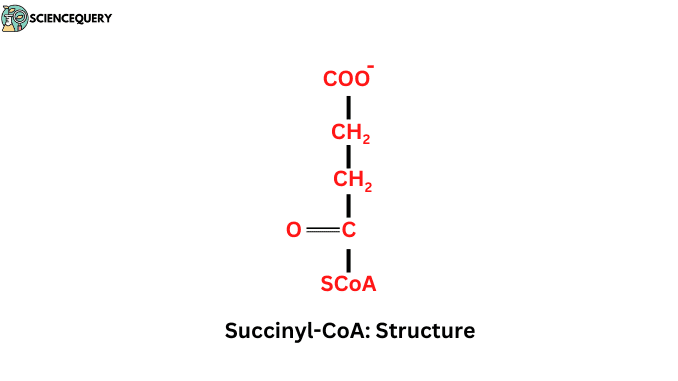
Know in one minute about Succinyl CoA
|
Definition
Succinyl CoA is an energy rich thioester compound, it is similar to Acetyl-CoA. It is an important intermediate of the TCA cycle. And is also involved in fatty acid and amino acid metabolism.
Synthesis of Succinyl-CoA in the TCA cycle
- In the TCA cycle, it is synthesized from alpha-ketoglutarate. This reaction is catalyzed by alpha-ketoglutarate dehydrogenase.
- It is a multienzyme Complex and similar to the pyruvate dehydrogenase complex.
- The multienzyme complex consists of alpha-ketoglutarate dehydrogenase, dihydrolipoyl transsuccinylase, and dihydrolipoyl Dehydrogenase as three catalytic subunits.
- The multienzyme complex – alpha-ketoglutarate dehydrogenase oxidatively decarboxylated alpha-ketoglutarate to succinyl-CoA.
- The reaction involves the reduction of NAD to NADH and the formation of a molecule of CO2.
Alpha-ketoglutarate + CoA + NAD → Succinyl CoA + CO2 + NADH
- Succinyl-CoA is also Synthesized from propionyl CoA. Propionyl CoA carboxylate to D-methyl malonyl. D- methylmalonyl converts to L-methylmalonyl.
- It rearranged and formed Succinyl-CoA through a Vitamin B12-dependent enzyme.
Uses and functions
- The enzyme Succinyl-CoA synthetase (SCS) is the only known mitochondrial enzyme that helps in the production of ATP.
- This process is done via substrate-level phosphorylation in the presence of oxygen.
- Not only this, but this compound is also useful and plays an important pivotal role in the citric acid cycle, heme synthesis, and ketone metabolism (1).
Other uses and functions of this compound are as follows
Porphyrin biosynthesis
Succinyl CoA is the starting material for porphyrin biosynthesis. Porphyrin like hemoglobin, myoglobin, etc.
Synthesis of succinate
Succinyl CoA synthesized Succinate in the TCA cycle.
Importance
- It is important for porphyrin Synthesis. Succinyl CoA and glycine are attached to formed delta-aminolevulinic acid, it is a precursor of Porphyrin synthesis.
- This reaction is catalyzed by the ALA synthase enzyme. This process is the starting point for the biosynthesis of hemoglobin.
- It also plays a key role in fatty acid and amino acid metabolism.
- In gluconeogenesis: In gluconeogenesis, Isoleucine, Methionine, and Valine convert to succinyl-CoA which is then converted to glucose through several stages.
What is Succinyl CoA synthetase?
- Succinyl CoA synthetase knew as Succinate thiokinase. It is an enzyme found in mitochondria.
- It catalyzed the reaction of succinyl CoA to Succinate resulting in phosphorylation of GDP to GTP.
- It is a reversible reaction and takes place in mitochondria.
- It is one of the mitochondrial enzymes which is capable of generating ATP through substrate level Phosphorylation in the anaerobic condition.
What is Succinyl CoA to succinate?
Succinyl-CoA synthetase converts succinyl-coenzyme A to succinate. The free energy of the thioester bond is conserved in this reaction by the formation of “high-energy” GTP from GDP – iP.
Succinyl CoA + GDP + iP + H2O → succinic acid + GTP + CoA
GTP + ADP → ATP + GDP
- Guanosine nucleotides participate in the conversion of succinyl-CoA to succinate, a reaction that is coupled to the substrate-level phosphorylation of GDP to GTP in the citric acid cycle.
- GTP serves as an energy source for protein synthesis. GTP again reacted with ADP and produced one ATP molecule and one GDP molecule.
- Succinyl coenzyme A synthetase is an enzyme that catalyzes the reversible reaction of succinyl-CoA to succinate.
Deficiency of Succinyl-CoA in the body
Succinyl-CoA is an intermediate in the citric acid cycle (2). This compound is further converted to succinate. and this is very important in many metabolic activities of our body and has a pivotal role in many biological activities.
-
Deficiency causes the disruption of heme synthesis
This compound is required with glycine for the formation of alpha-aminolevulinic acid in the first step of porphyrin and heme synthesis (3). The deficiency of these compounds can eventually cause the deficiency of vitamin B12 and thus ultimately the heme and the energy production.
-
Neuromotor dysfunction
The deficiency of heme due to insufficient Succinyl-CoA causes neuromotor dysfunction (4).
Growth retardation
Due to the heme disruption as discussed above, growth retardation can happen. The gluconeogenesis deficiency together with heme synthesis deficiency whereas the reason for the neurological abnormalities can be glycine increase in the tissue due to decreased heme synthesis (4).
Q&A
Why does Succinyl-CoA inhibit citrate synthase?
It competes with acetyl-CoA in the Citrate synthase reaction (competitive feedback inhibition).
How many carbons does Succinyl-CoA have?
It has four carbon atoms.
Which amino acids supply carbons for eventual entry into metabolism as Succinyl-CoA?
Isoleucine, Methionine, and Valine supply carbons for eventual entry into metabolism as this compound.
What is Succinyl-CoA used for?
Is an energy-rich compound. It is useful for the production of energy. Succinate and Porphyrins are synthesized from this compound.
